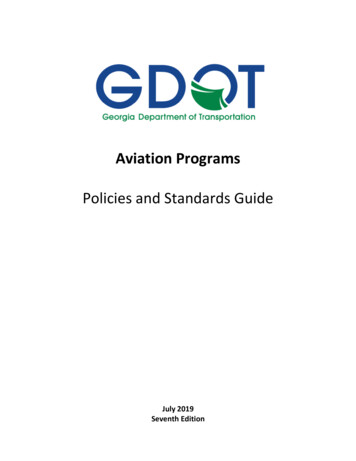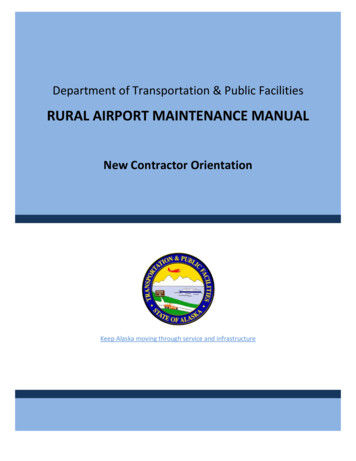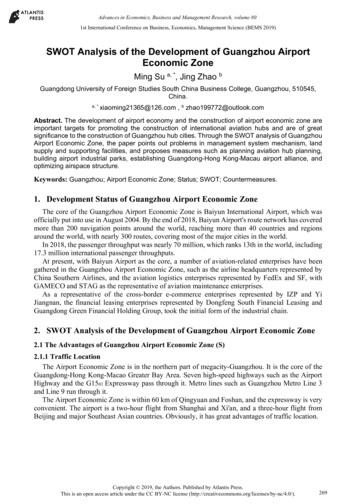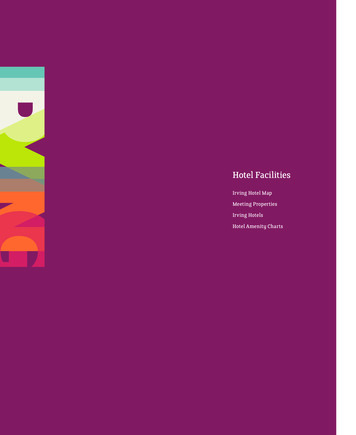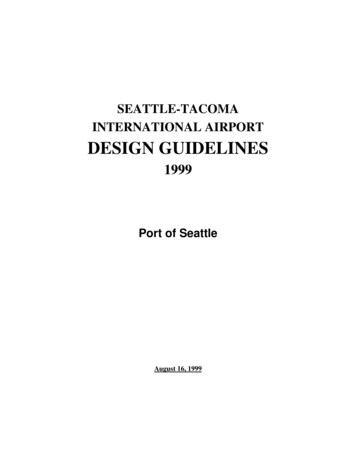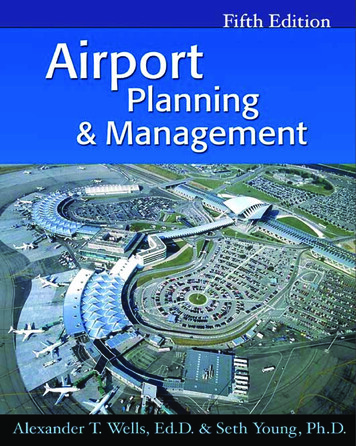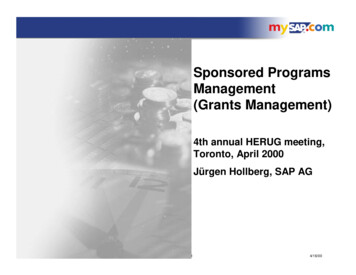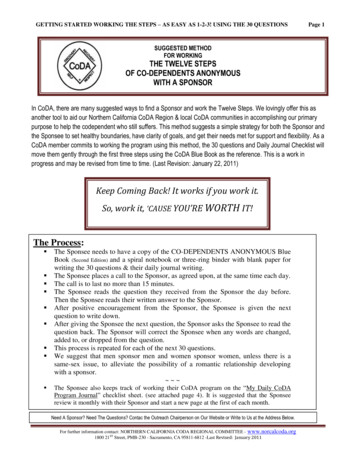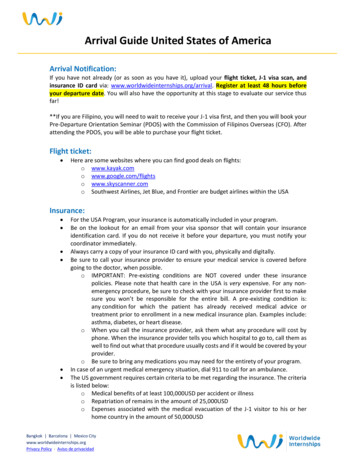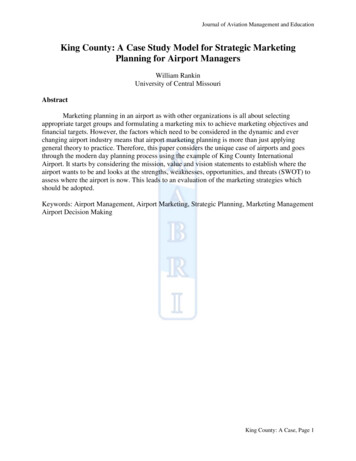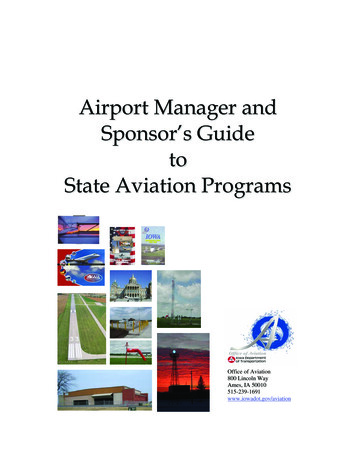
Transcription
Airport Manager andSponsor’s GuidetoState Aviation ProgramsOffice of Aviation800 Lincoln WayAmes, IA 50010515-239-1691www.iowadot.gov/aviation
Airport Manager and Sponsor’s GuideTo State Aviation Programs and ServicesThe role of the Iowa Department of Transportation’s (Iowa DOT) Office of Aviation is toadvocate for aviation, administer state and federal aviation funding programs, enhancesafety, and provide technical services to the aviation community. This guide has beendeveloped to provide airport managers and sponsors with information about the services,programs and grants available through the Office of Aviation.Aviation programs in Iowa are funded through the State Aviation Fund using aircraftregistration fees and aviation fuel taxes paid by aviation users; as well as annualappropriations by the Iowa Legislature from the Vertical Infrastructure/Restrictive Capitalfund to support improvements to vertical infrastructure at airports throughout the state. Moreinformation on funding programs can be found in the second section of this guidebook.The guide is divided into three sections. The first section provides an overview of the Officeof Aviation’s initiatives and services, along with links to additional resources. The secondsection reviews state funding programs, including the processes for application andadministration of grants. The third section describes the Federal pre-application process andthe role that the Iowa DOT plays in the Federal Airport Improvement Program.This sponsor guide and additional resource information are available on the Office ofAviation web site at www.iowadot.gov/aviation.Office of Aviation800 Lincoln WayAmes, IA 50010515-239-1691www.iowadot.gov/aviation
Airport Manager and Sponsor’s Guide to State Aviation Programs and ServicesRevised September 2009Airport Manager and Sponsor’s GuideTo State Aviation Programs and ServicesTable of ContentsIntroductionSection 1: Office of Aviation ServicesAircraft Registration .Airport Inspections, Public Use Landing Certificates, and 5010 Data Updates Air Service Development .Aviation Advocacy and Education .Aviation System Planning .Automated Weather Observing Systems . Data Collection and Analysis Directories and Aeronautical Charts .Electronic Business Communications .General Aviation Security .Land Use Near Airports .Pavement Management .Runway Markings .Wildlife Consultations and Mitigation .Windsocks ion 2: State Aviation Grant ProgramsGrant Program Descriptions .Airport Improvement Program .Aviation Safety .Operational Emergencies Pavement Maintenance .Wildlife Mitigation .Aviation Planning and Development .Airfield Development and Security Grants .Air Service Development-Sustainment .Air Service Development-Enhancement Land Use Planning and Zoning .Vertical Infrastructure Programs .General Aviation Vertical Infrastructure (GAVI) .Commercial Service Vertical Infrastructure (CSVI) .Grant Administration .Grant Agreement and Execution Grant Provisions .Grant Amendments Sponsor Assurances Consultant/Engineering Agreements .Consultant/Engineering Agreements Audit Requirements .Project Bidding Requirements .Targeted Small Business Requirements .Request for Reimbursement .Grant Closeout 82-82-82-82-92-92-102-102-11
Airport Manager and Sponsor’s Guide to State Aviation Programs and ServicesRevised September 2009
Airport Manager and Sponsor’s Guide to State Aviation Programs and ServicesRevised September 2009Section 3: State Role in Federal Airport Improvement ProgramNon-Primary Entitlement .Planning, Planning, Planning .Eligible Projects Justified Projects .Revenue Producing Projects .Airport Capital Improvement Program ACIP Data sheets .Federal Airport Improvement Program (AIP) Pre-Applications Appendix A – Sample Application FormsAirfield Development and Vertical InfrastructureProject data sheet5-Year CIPSponsor ResolutionAirport Planning and ZoningOperational EmergenciesPavement MaintenanceWildlife MitigationMinority Impact StatementAppendix B – AgreementsAirport Improvement ProgramVertical Infrastructure ProgramOperational EmergencyWildlife MitigationAppendix C – Grant Administration FormsClaim for ReimbursementStatement of Final AcceptanceAppendix D – Bidding/Consultant InformationEngineering Use RequirementsTargeted Small BusinessCompetitive Quote GuidelinesAppendix E – AWOSAWOS Function and Troubleshooting GuideAgreement between Iowa DOT and Airport with State Maintained AWOSAppendix F – GlossaryAppendix G – MiscellaneousFederal Fish & Wildlife Permit Application FormWildlife Categories in Iowa and Permits Necessary for Lethal ControlFrequently Used Airport Related FAA Advisory Circulars3-13-13-23-33-33-33-3
Airport Manager and Sponsor’s Guide to State Aviation Programs and ServicesRevised September 2009
Airport Manager and Sponsor’s Guide to State Aviation Programs and ServicesRevised April 2010Section 1: Office of Aviation ServicesAircraft RegistrationSince 2006, the Office of Aviation has managed the Iowa Aircraft Registration Program. Iowalaw requires all aircraft based and/or operated in the state more than 30 days annually to beregistered each year with the Iowa Department of Transportation. Aircraft registration fees aredeposited into the State Aviation Fund to help pay for aviation programs. As part of theaircraft registration program, the Office of Aviation also administers the collection of a onetime use tax based on the purchase price of an aircraft. The office also manages aircraftdealer certification.Resources: Aircraft Registration Information and tration/registration.htmlAirport Inspections, Public Use Landing Certificates and 5010 Data UpdatesThe Office of Aviation has a responsibility to ensure that public-use airports in the state meetminimum airport safety standards. Minimum state safety standards are established by theIowa DOT in the Iowa Administrative Code 761-720. Airports that are eligible to receivefederal funds are also required to meet Federal Aviation Administration airport designstandards.An airport open for public use is required by Iowa Code Section 328.19 to obtain a public uselanding certificate and to renew the certificate annually. Public use landing certificates may berenewed in one of two ways:1) Airport is inspected by the Office of Aviation Airport safety inspections are conducted throughout the year. During theseinspections, the inspector will look at runway conditions, airport markings, airportlighting, runway approach angles and controlling runway obstructions. Airportmanagers may or may not be present during the inspections. After an inspection iscompleted, the airport manager is notified by letter and/or email if any corrections areneeded by the airport to maintain public use status. Airports are provided areasonable period of time to make the necessary corrections prior to reissuance of thelanding certificate.2) Airport submits a renewal application Airports that are not inspected will receive an annual renewal application, whichincludes a copy of the state minimum safety standards and the 5010 Airport MasterRecord. The application requires the airport sponsor to review and make necessarycorrections to the FAA’s 5010 Airport Master Record, and to certify that the airport ismaintaining state minimum safety standards. Airport sponsors should read the 5010information carefully, and make sure that any changes are submitted to the Office ofAviation.The Office of Aviation will issue a public use landing certificate to the airport after verifying thatminimum state safety standards are met. The Certificate should be displayed in a public areaat the airport. The Office of Aviation will submit 5010 Airport Master Record changes to theFAA.Section 1 – Aviation ServicesPage 1 of 6
Airport Manager and Sponsor’s Guide to State Aviation Programs and ServicesRevised April 2010Commercial service airports are inspected annually by the FAA under Federal AviationRegulations Part 139 and are not inspected by the Iowa DOT.Resources: State Minimum Safety t/iac/761iac/761720/761720.pdf5010 Airport Database http://www.gcr1.com/5010web/#Air Service DevelopmentThe state of Iowa plays a role in the development of air service in Iowa through data analysisof fares and capacity, statewide air service studies, support of federally funded air serviceprograms, funding of infrastructure needs, and support of a statewide Air ServiceDevelopment funding program.The statewide Air Service and Economic Impact study for Commercial Service Airportsreleased in 2008 provided detailed information to assist in sustaining and improving air servicein Iowa.Resources: Iowa Air Service s/servicestudy.htmlAviation Advocacy and EducationThe Office of Aviation participates in a variety of outreach and educational activities designedto inform and educate the general public, the aviation community, and decision makers at thelocal, state, and national levels. At the core of the outreach and education activities is acommunications program with web site, newsletter, “Hot News” e-mail updates, and mediareleases. Additionally, the office provides technical expertise on a variety of aviation issues toairports, FBO's, pilots, media, government agencies, legislators, and the general public.The office also supports educational programs such as the annual Iowa Aviation Conference,and sponsorship of training programs for pilots, aviation maintenance technicians, and airportconsultants. Outreach efforts are conducted as-needed to address topics involving timelyissues such as agricultural aviation, land use planning around airports, safety issues in thehelicopter EMS operating environment, and others as the need arises.The Office of Aviation promotes aviation through public speaking engagements, exhibits atkey events, support of Iowa Aviation Youth Camps, the Iowa Aviation Photography Contest,educational give-a-ways (i.e balsa planes, activity books), and providing letters from Iowa'sgovernor to EAA Young Eagle participants.Resources: Office of Aviation Web site: www.iowadot.gov/aviationAviation System PlanningThe Iowa DOT, in partnership with the FAA and local airport sponsors, strives to ensure thatthe aviation system is positioned to meet needs of the system users. The system plan is animportant tool to guide development and monitor the ability of the system to meet the needs.Programming decisions are made using the facility and service objectives for airport rolesidentified in the system plan. Periodic updates of the system plan will re-evaluate systemroles and provide a measurement of key benchmarks to monitor the effectiveness of theaviation system.Section 1 – Aviation ServicesPage 2 of 6
Airport Manager and Sponsor’s Guide to State Aviation Programs and ServicesRevised April 2010Occasionally, special reports are issued that address specific issues involving Iowa’s airtransportation system. These reports assist in planning efforts involving the air transportationsystem by providing information to system users, decision makers, and the general public.Resources: Iowa Aviation System Plan Executive SummaryIndividual reports found systemplanreports.(click on airport of choice, report under technical reports)Ag Aviation SummitAir Service and Economic Impact Study for Commercial AirportsEconomic Impact - Uses and Benefits of Aviation in IowaHelicopter Emergency Medical ServicesAutomated Weather Observing System (AWOS)The Iowa DOT maintains a weather system that provides a network of aviation weatherreporting stations at airports throughout the state. The Iowa DOT contracts for themaintenance of the statewide system and the transfer of data to the national weather systemfor those sites approved as part of the state system. Airports included in the state system arestrategically located across the state to complement airports that have federally supportedweather stations. The state system planning process identifies the need for any additionalsites; any airport wishing to add a site to the state system must have approval from the IowaDOT prior to installation.Airports that have an AWOS included in the state system are required to provide electricalpower to operate the equipment and to maintain clear access to the site. Airports must alsokeep vegetation and other objects 100 feet away from the unit to avoid system interference.The airport is responsible to avoid AWOS communication lines during construction projects,and the airport will be responsible for correcting any disruption to service due to airportconstruction projects. In addition, airport managers or operators may be asked to providesimple troubleshooting tasks that help maintain the accuracy of the system. Appendix Eincludes an AWOS Guide that explains the operation of the equipment and troubleshootingtasks, as well as specific responsibilities. Appendix E also includes a sample agreement thatairports are asked to sign with the Iowa DOT identifying responsibilities for the maintenance ofan AWOS system.Resources: AWOS Web site: http://weatherview.iowadot.gov/AWOS brochure: rochure.pdfData Collection and AnalysisThe Office of Aviation maintains an Airport Management System database that includes awide range of information including airport airside and landside facilities, contact information,and planning data. This database is updated through the annual 5010 record updates,system plan updates, airport layout plan updates, special surveys, and notifications fromairport managers. The information is used to update aviation system benchmarks, monitor theeffectiveness or need for programs, and to respond to requests for information.Section 1 – Aviation ServicesPage 3 of 6
Airport Manager and Sponsor’s Guide to State Aviation Programs and ServicesRevised April 2010Directories and Aeronautical ChartsAirport and heliport data maintained by the Office of Aviation is used to publish the AirportDirectory every two years and the Heliport Directory as needed. Current versions of bothdirectories are available at http://www.iowadot.gov/aviation/airports/main.htm. Heliport usersor operators can report updated heliport information from the heliport web page. Updates andcorrections to the Airport Directory can be reported to the Office of Aviation Airport Inspector.The Office of Aviation also prints and distributes the Iowa Aeronautical Chart every two years.The Iowa Chart is intended to be used as a supplement to, and should not be used in lieu ofcurrent sectional charts.Electronic Business CommunicationsIt is important for managers and sponsors to notify the Office of Aviation when contactinformation, including e-mail addresses, change. Much of the correspondence from the office,including solicitation for state applications, is now done through e-mail.General Aviation SecurityAirport sponsors are encouraged to be proactive in enhancing security at airports byassessing current conditions, and developing and implementing a security plan. The Office ofAviation provides a template and information needed to develop a security plan. Securitysigns were distributed to all airports, and continue to be available as needed at no charge toairports. Airports requesting security related projects must have an airport security plan on filewith the Office of Aviation. Commercial service airports are not required to have securityplans on file with the Office of Aviation to be eligible for security related projects.Resources: Security plan template and airport signage - Office of Aviation 515-239-1048TSA guidelines for general aviationhttp://www.tsa.gov/assets/pdf/security guidelines for general aviation airports.pdfTSA General Aviation Web sitehttp://www.tsa.gov/what we do/tsnm/general aviation/index.shtmAOPA Watch Program http://www.aopa.org/airportwatch/AOPA General Aviation Security urity.cfmLand Use Near AirportsEnsuring compatible land use near an airport is very important to maintaining safety and thefuture viability of the airport. The Office of Aviation developed the Iowa Land Use Guidebookthat identifies five airport land use zones corresponding to the runway protection zone andPart 77 surfaces to assist local planners with identifying compatible land use near airports. Inaddition to tall structures, land uses that would encourage high concentrations of people,create visual obstructions, and/or attract wildlife may be inappropriate dependent on proximityto the airport. The guidebook encourages planning and also provides mitigation techniquesfor incompatible land use that may already exist.Airport managers and sponsors are encouraged to become familiar with the guidebook andwork with local jurisdictions to ensure that land uses near airports remain compatible throughcomprehensive planning and zoning. The Iowa DOT initiated a new grant program for airportsponsors to develop or update city or county comprehensive plans and zoning ordinances. ASection 1 – Aviation ServicesPage 4 of 6
Airport Manager and Sponsor’s Guide to State Aviation Programs and ServicesRevised April 2010sponsor assurance for accepting state funding for airport projects requires airports to protectthe air space according to FAA Part 77.Any construction on public use airport property or near public use airports requires an airspace evaluation. Consult the FAA obstruction evaluation web site to determine notificationrequirements. The obstruction evaluation web site should also be routinely reviewed tomonitor proposed construction near your airport.Resources: Iowa Land Use Guidebook and eports/compatibleland.htmlAirport Zoning (Iowa Code Chapter 329): sp?category billinfo&service IowaCode&ga 83Obstruction evaluation: pPavement ManagementThe Office of Aviation, with the assistance of the FAA, oversees periodic pavementinspections at airports eligible for federal funds to provide airport sponsors with tools tomaximize the life of the airfield pavements. The inspections and management reports arealso used by the Office of Aviation and the FAA to prioritize projects. Airport sponsors areencouraged to use the pavement management reports and required to conduct routineinspections and maintenance to provide longer term usability of pavements.Resources: Individual airport pavement condition inspection reports al.asp -click on the airport ofinterest.Runway MarkingsThe Runway Marking Program provides critical safety markings at public-owned generalaviation airports to provide key operational information to pilots on the ground and from theair. Airport markings are updated on a rotating basis or as needed.Wildlife MitigationWildlife can become safety hazards at airports. Airports should take efforts to decrease thepotential for aircraft wildlife strikes. The Office of Aviation has a cooperative effort with theUSDA Animal and Plant Health Inspection (APHIS) Wildlife Services to provide wildlifeconsultations and mitigation at airports in Iowa. Wildlife consultations were completed at allenhanced service and general service airports. It was found that geese, birds, deer andcoyote were the most common wildlife problems at airports in Iowa.The wildlife hazard consultations provided recommendations for habitat management andsuggestions for mitigation if needed. Mitigation efforts may include harassment, control, orremoval. The Office of Aviation provides funding and coordinates mitigation efforts at airportswith the USDA Wildlife Services.In order for deer to be removed from an airport, a shooting permit must be issued by the IowaDept of Natural Resources. Permits are also required for the removal of geese and othermigratory birds. Wildlife Services can help coordinate the issuance of permits with theappropriate agencies. A listing of wildlife needing permits is in Appendix G.Section 1 – Aviation ServicesPage 5 of 6
Airport Manager and Sponsor’s Guide to State Aviation Programs and ServicesRevised April 2010Resources: Iowa DNR wildlife damage information and depredation les/depredation contact.pdfUSDA Wildlife Services biologist: Ernie.Colboth@aphis.usda.govFederal Fish and Wildlife License/Permit Application Form – Appendix GWildlife Categories in Iowa and Permits Necessary – Appendix GWindsocksWindsocks are basic safety tools that provide valuable information to pilots regarding winddirection and speed prior to takeoff and landing. Windsocks are provided to airports andheliports by contacting the Office of Aviation at 515-239-1691.Section 1 – Aviation ServicesPage 6 of 6
Airport Manager and Sponsor’s Guide to State Aviation Programs and ServicesRevised April 2010Section 2: State Aviation Grant ProgramsEffective airport planning for future improvements is important for local airport sponsors inorder to meet the aviation demands for their airport. Each year as airport sponsors begin thelocal funding planning cycle, the short term and long term goals of the airport should beaddressed. Airport layout plans, master plans, state system plan and other local planningefforts should be addressed to determine a five-year capital improvement program thatincludes potential federal and state projects.The Office of Aviation administers two major categories of state aviation funding programs:the Airport Improvement Program and the Vertical Infrastructure programs. Fundingallocations for the programs and project selection are approved by the Iowa TransportationCommission. This section of the sponsor guide provides descriptions and applicationprocesses for the grant programs, and the grant administration process.Airport Improvement ProgramThe Airport Improvement Program, funded by the State Aviation Fund, includes aviation safetyprograms and aviation planning and development programs. These programs assist airportsand the Office of Aviation in preserving and enhancing the air transportation system in Iowa.Aviation Safety – All grants in this category are available on an ongoing basis throughoutthe year as long as funds are available. Application forms, state share, sponsor eligibilityand project eligibility vary for each specific type of grant. Operational Emergencies – Program is intended to assist airports with repairsto safety related equipment and infrastructure that may malfunction outside thetypical grant application process. Eligible applicants are sponsors of public owned airports. Eligible projects include runway and taxiway lighting, communicationequipment, navigational aids, and runway blow-ups. Applications may be submitted via fax or mail, should include twoestimates and must be requested prior to beginning work. (Iowa DOTForm 291110) A Minority Impact Statement (Iowa DOT Form 105101)must also be attached to the application. Project selection and approval occurs as applications are submitted. Ifthe project is eligible and funding is available, the Office of Aviation mayapprove the grant. Two copies of a signed agreement are sent to the sponsor for signature.The sponsor must sign the agreements and return one copy prior toauthorization to proceed with the work. State share is 70%, with a maximum grant of 5,000.Resources: Emergency Operations Application orms/GetTemplate.aspx?did 639Sample application form – Appendix AMinority Impact adotforms/GetTemplate.aspx?did 737Section 2 – State Aviation Grant ProgramsPage 1 of 11
Airport Manager and Sponsor’s Guide to State Aviation Programs and Services Revised April 2010Pavement Maintenance – Program is intended for airports to perform routinemaintenance to prolong the life of pavement before needing major rehabilitation. Eligible applicants are sponsors of public owned airports. Eligible projects include runway, taxiway and apron crack sealing andrunway blowup repair. Applications can be submitted via fax or mail and must be requested priorto beginning work. (Iowa DOT Form 291117) A Minority ImpactStatement (Iowa DOT Form 105101) must also be attached to theapplication. Project selection and approval occurs as applications are submitted. Ifthe project is eligible and funding is available, the Office of Aviation mayapprove the grant. Two copies of a signed agreement are sent to the sponsor for signature.The sponsor must sign the agreements and return one copy prior toauthorization to proceed with the work. State share is 70%, with a maximum grant of 10,000.Resources: Pavement Maintenance Application orms/GetTemplate.aspx?did 770Minority Impact adotforms/GetTemplate.aspx?did 737 Wildlife Mitigation – Program is intended to assist airports in mitigating andremoving wildlife from airports to reduce the potential for wildlife strikes. An initialconsultation or wildlife study conducted by the USDA Wildlife Services should becompleted prior to applying for mitigation. Eligible applicants are sponsors of general aviation public owned airports. Eligible projects include wildlife harassment, control, and complete wildlifestudies. Applications can be submitted via fax or mail and should identify specificwildlife issues that need to be mitigated. (Iowa DOT Form 291116) AMinority Impact Statement (Iowa DOT Form 105101) must also beattached to the application. Project selection and approval occurs as applications are submitted. Ifthe project is eligible and funding is available, the Office of Aviation mayapprove the grant. The Iowa DOT will coordinate with Wildlife Services(WS) to determine the type of mitigation services that WS will performand the costs for the services. The sponsor will be asked to sign an agreement with the Iowa DOTagreeing to reimburse the Iowa DOT after completion of the project. Twocopies of a signed agreement are sent to the sponsor for signature. Thesponsor must sign the agreements and return one copy prior toauthorization to proceed with the work. State share is 85%. The Iowa DOT will pay initial costs to the WS andrequest reimbursement for the sponsor’s 15% share after the project iscompleted.Resources: Wildlife Mitigation Application orms/GetTemplate.aspx?did 769Minority Impact adotforms/GetTemplate.aspx?did 737Section 2 – State Aviation Grant ProgramsPage 2 of 11
Airport Manager and Sponsor’s Guide to State Aviation Programs and ServicesRevised April 2010Aviation Planning and Development – These grants, with the exception of Air ServiceDevelopment and the land use planning and zoning grants, are included in the annualapplication package due in late April or early May. Sponsor eligibility and state share varyby type of grant. Airfield Development and Security Grants – Grant program to assist airportsponsors in the preservation and development of the airfield and relatedinfrastructure. Projects should be supported by the aviation system plan. Newconstruction must be shown on an airport layout plan. If sponsors are requestingsecurity related projects, a security plan must be on file with the Office ofAviation. Airport sponsors should be able to begin a project within twelve monthsof accepting a grant. Eligible applicants are sponsors of public owned airports. Eligible projects include runway, apron and taxiway construction andrehabilitation; pavement maintenance; drainage; obstruction removal;signage and lighting; navigation and communication aides; landacquisition; fuel facilities; security related projects such as lighting oraccess control; planning studies such as airport layout plans (ALPs),master plans, and multi-jurisdictional feasibility studies. Application information is available on the Office of Aviation Web site ande-mailed to sponsors in late January. Applications are due late April orearly May. A completed application package includes: an application form with contact information and summary ofrequested projects (Iowa DOT Form 291114); a project detail sheet that provides a description, justification, anddetailed cost estimate for each project (Iowa DOT Form 291115); 5-year capital improvement plan (CIP) that shows planned federaland state projects (Iowa DOT Form 291112); a resolution showing commitment of local support; documentation of an updated airport layout plan and security plan ifrequired for the type of project requested; and a Minority Impact Statement (Iowa DOT Form 105101). Projects are reviewed and prioritized based on system plan objectives,airport role, type of pr
1) Airport is inspected by the Office of Aviation - Airport safety inspections are conducted throughout the year. During these inspections, the inspector will look at runway conditions, airport markings, airport lighting, runway approach angles and controlling runway obstructions. Airport m
